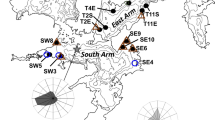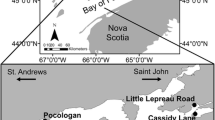Abstract
This study examined factors affecting juvenile recruitment in the tuatua Paphies donacinaon an exposed surf beach in Pegasus Bay, South Island New Zealand between October 1994 and April 1997. Tuatua recruitment followed female gonad maturation with a delay of approximately 2 months. Juveniles (1–10 mm shell length) occurred throughout the study except during June and July 1995 (winter). Average densities (m−2 ) were 28 in winter, 230 in spring, 174 in summer and 108 in autumn. There was high juvenile mortality and/or emigration and the maximum average density of (741m−2 ) was recorded in November 1996. Recruit densities were similar between years except during winter. Adult tuatua populations were dominated by modal shell lengths greater than 70 mm.There was no significant relationship between adult and juvenile recruit length. Recruit length decreased with recruit density suggesting density dependent competition for space or food resources. Juvenile density increased following increases in food availability (chlorophyll a concentration) but average length of juveniles did not correlate directly with any of the environmental variables. Recruit density decreased as the modal adult length increased and recruit length reduced when adult populations had a high condition index. Because larvae, juveniles and adult are mobile the beach population is characteristic of an open system with adults and juveniles from the resident population affecting post-settlement density- dependent processes.
Similar content being viewed by others
References
Ansell, A. D., 1983. The biology of the genus Donax. In McLachlan, A. & T. Erasmus (eds), Sandy Beaches as Ecosystems: 607–635.
Ansell, A. D. & A. Bodoy, 1979. Comparison of the events in the seasonal cycle for Donax vittatus and Donax trunculus. In Naylor, E. & R. G. Hartnoll (eds), Cyclic Phenomena in Marine Plants and Animals. Oxford: Pergamon Press: 191–198.
Bayne, B. L., 1976. Aspects of reproduction in bivalve molluscs. In Wiley, M. (ed.), Estuarine Processes. Vol. 1. Uses, Stresses and Adaptation to the Estuary. Academic Press. London: 432–448.
Beu, A. G. & L. A. de Rooij-Schuiling, 1982. Subgeneric classification of New Zealand and Australian species of Paphies Lesson (Bivalvia: Mesodesmatidae) and the names for the two species of tuatua in New Zealand. N Z J. Zool. 9: 211–230.
Beukema, J. J., R. Dekker, K. Essink & H. Michaelis, 2001. Synchronised reproductive success of the main bivalve species in the Wadden Sea: causes and consequences. Mar. Ecol. Prog. Ser. 211: 143–155.
Brown, A. C., 1983. The ecophysiology of sandy beach animals-a partial review. In McLachlan, A. & T. Erasmus (eds), Sandy Beaches as Ecosystems: 575–605.
Brown, A. C. & A. McLachlan, 1990. Ecology of Sandy Shores. Elsevier, Amsterdam.
Burgess, J. S., 1968. Beach morphology in southern Pegasus Bay. M.A. in Geography, University of Canterbury: 98 pp.
Coe, W. R. & J. E. Fitch, 1950. Population studies, local growth rates and reproduction of the Pismo clam (Tivela stultorum). J. Mar. Res. 9: 188–210.
Cranfield, H. J., K. P. Michael & R. I. C. C. Francis, 1996. Growth rates of five species of subtidal clam on a beach in the South Island. Mar. Freshwat. Res. 47: 773–784.
Cranfield, H. J., K. P. Michael, D. Stotter & I. J. Doonan, 1994. Distribution, biomass and yield estimated of surf clams off New Zealand. N Z. Fish. Ass. Res. Doc. 94/1.
Davidson, R. J., 1989. Natural food and predatory activity of the paddle crab Ovalipes catharus: a flexable forager. M.Sc. Thesis, University of Canterbury: 110 pp.
Dawson, E. W., 1954. Studies on the biology of Amphidesma, an intertidal mollusc of the sandy shore. M.Sc. thesis, University of Canterbury.
Defeo, O., 1993. Repopulation of coastal invertebrates through the management of natural areas: a successful example. Out of the shell 3: 11–13.
Defeo, O., E. Oritz & J. C. Castilla, 1992. Growth, mortality and recruitment of the yellow clam Mesodesma mactroides in Uroguayan beaches. Mar. Biol. 114: 429–437.
Dugan, J. E. & A. McLachlan, 1999. An assessment of longshore movement in Donax serra Roding (Bivalvia: Donacidae) on an exposed sandy beach. J. exp. mar. Biol. Ecol. 234: 111–124.
Emerson C. W. & J. Grant, 1991. The control of soft-shell clam (Mya arenaria) recruitment on intertidal sandflats by bed-load sediment transport. Limnol. Oceanog. 36: 1288–1300.
Grant, C. M., 1994. Demographics and reproduction of the tuatua-Paphies subtriangulata. M.Sc. thesis, University of Auckland.
Grant, C. M. & R. G. Creese, 1995. The reproductive cycle of the tuatua-Paphies subtriangulata (Wood, 1828), in New Zealand. J. Shell. Res. 14: 287–292.
Haddon, M., T. J. Willis, R. G. Wear & V.C. Anderlini, 1996. Biomass and distribution of five species of surf clam off an exposed west coast North Island beach, New Zealand. J. Shell. Res. 15: 331–339.
Harvey, M. & B. Vincent,1990. Density, size distribution, energy allocation and seasonal variations in shell and soft tissue growth at two tidal levels of a Macoma balthica (L.) population. J. exp. mar. Biol. Ecol. 142: 151–168.
Harvey, M., B. Vincent & Y. Gratton, 1993. Spatial variability in the length-specific production in shell somatic products of Macoma balthica in the Lower St. Lawrence Estuary. II large scale variability. Mar. Biol. 15: 421–433.
Kenny, P. D., W. K. Michener & D. M. Allen, 1990. Spatial and temporal patterns of oyster settlement in a high salinity estuary. J. Shell. Res. 9: 329–339.
King, B. E., 1997. Comparative aspects of gonad development in field and laboratory conditioned surf clams from Foxton Beach, New Zealand. M.Sc. Thesis, Victoria University, Wellington, New Zealand.
Lima, M., A. Brazeeiro & O. Defeo, 2000. Population dynamics of the yellow clam Mesodesma mactroides: recruitment variability, density-dependence and stochastic processes. Mar. Ecol. Prog. Ser. 207: 97–108.
Manzi, J., M. Bobo & V. Burrell, Jr., 1985. Gametogenesis in a population of the hard clam, Mercenaria mercenaria (Linnaeus), in North Santee Bay, South Carolina. Veliger 28: 186–194.
Marsden, I. D., 1999a. Respiration and feeding of the surf clam Paphies donacina from New Zealand. Hydrobiologia 405: 179–188.
Marsden, I. D., 1999b. Reproductive cycles of the surf beach clam Paphies donacina (Spengler, 1793) from new Zealand. J. Shell. Res. 18: 539–546.
Marsden I. D., 2000. Variability in low-tide populations of tuatua, Paphies donacina, in Pegasus Bay, Canterbury, New Zealand. NZ J. mar. FW Res. 34: 359–370.
Masski, H. & J. Guillou, 1999. The role of biotic interactions in juvenile mortality of the cockle (Cerastoderma edule): Field observations and experiment. J. Shell. Res. 18: 575–578.
McLachlan, A. & T. Erasmus, 1983. Sandy beaches as ecosystems. Dr Junk Publishers, The Hague.
McLachlan, A., J. E. Dugan, O. Defeo, A. D. Ansell, D. M. Hubbard, E. Jaramillo & P. E. Penchaszadeh, 1996. Beach clam fisheries. Oceanog. mar. biol. Ann. Rev. 34: 163–232.
McLachlan, A. & E. Jaramillo, 1995. Zonation on sandy beaches. Oceanog. mar. biol. Ann. Rev. 33: 305–335.
McLachlan, A., E. Jaramillo, O. Defeo, J. Dugan, A. de Ruyck & P. Coetee, 1995. Adaptations of bivalves to different beach types. J. exp. mar. Biol. Ecol. 187: 147–160.
Moroney, D. A. & R. L. Walker, 2001. Recruitment patterns of the eastern oyster, Crassostrea virginica, along a creek gradient in House Creek, Little Yybee Island, Georgia. J. Shell. Res. 17: 1085–1091.
Norkko, A., V. J. Cummings, S. F. Thrush, J. E. Hewitt & T. Hulme, 2001. Local dispersion of juvenile bivalves: implications for sandflat ecology. Mar. Ecol. Prog. Ser. 212: 131–144.
Olafsson, E. B., C. H. Peterson & W. G. Ambrose, 1994. Does recruitment limitation structure populations and communities of macro-invertebrates in marine soft sediments: the relative importance of pre-and post settlement processes. Oceanogr. mar. biol. Ann. Rev. 32: 65–95.
Redfearn, P., 1974: Biology and distribution of the toheroa, Paphies (Mesodesma) ventricosa (Gray). New Zealand Fisheries Bulletin 11. Fisheries Research Division: 51 pp.
Rickard, N. A. & R. A. Newman, 1986. Development of technology for harvesting and transplanting subtidal juveniles Pacific razor clams, Silequa patua Dixon, along the coast ofWashington state. J. Shell. Res. 7: 131.
Shaw, W. N. & T. J. Hassler, 1989. Species profiles: life histories and environmental requirements of coastal fishes and invertebrates (Pacific Southwest)-Pismo clam. U.S. Fish Wild. Rep. 82: 82–84.
Short, A. D., 1990. Macro-mesal tidal beach morphodynamics-an overview. J. Coast.
Tirado, C. & C. Salas,1998. Reproduction and fecundity of Donax trunculus L., 1758 (Bivalvia: Donacidae) in the littoral ofMalaga (Southern Spain). J. Shell. Res. 17: 169–176.
Todd, C. D., 1998. Larval supply and recruitment of benthic invertebrates: do larvae always disperse as much as we believe? Hydrobiologia 375/376: 1–21.
Author information
Authors and Affiliations
Rights and permissions
About this article
Cite this article
Marsden, I. Recruitment in the swash zone – temporal variations in juvenile recruitment of an exposed sand beach surf clam. Hydrobiologia 477, 47–57 (2002). https://doi.org/10.1023/A:1021012621336
Issue Date:
DOI: https://doi.org/10.1023/A:1021012621336




